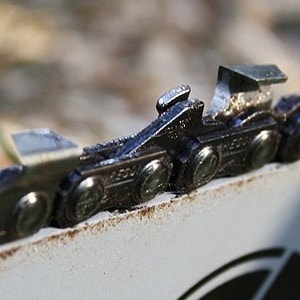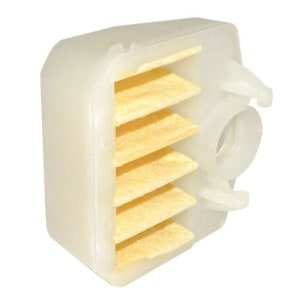 There is a lot to know when using a chainsaw. These are extremely dangerous power tools that can cause an accident if you don’t fully understand what you are doing.
There is a lot to know when using a chainsaw. These are extremely dangerous power tools that can cause an accident if you don’t fully understand what you are doing.
However, once you know the parts of a chainsaw, how each part functions, and how to better maintain and handle the tool, your risk of an accident is greatly reduced.
Today we are going to learn all about the components of a chainsaw. I will explain to you in the simplest terms each mechanism that makes the chainsaw run. By the time we are finished, my hope is that you will have a comprehensive understanding of how a chainsaw operates, and how its individual parts work together.
The Parts of a Chainsaw
Throttle: The throttle is the part of the chainsaw that controls how fast the chain spins. When using a gas chainsaw, the throttle determines the exact amount of fuel that is sent inside the combustion chamber. The harder the throttle is squeezed, the more fuel is sent into the combustion cylinders, and the faster the chainsaw runs.
When using a battery-operated cordless chainsaw, the throttle will increase the amperage in the motor to give you an increase in power.
Throttle Interlock: The throttle interlock is what stops the throttle from being activated accidentally. In order for you to unlock the throttle, the throttle interlock must first be pressed. Think of this like the safety mechanism.
Chain Catcher: The chain catcher is an extremely important safety mechanism found on the chainsaw. The chain catcher is a unique guard design to catch the chain if it somehow breaks while in the middle of spinning. This is an incredibly useful safety tool that protects you from being injured if your chain should snap.
 Chain Brake: The chain brake is another safety mechanism, one which stops the chain from spinning whenever there is an unexpected incident of kickback. Kickback can happen whenever the chain becomes pinched. Kickback results in a violent upward thrust of the chainsaw, which usually goes right for your face.
Chain Brake: The chain brake is another safety mechanism, one which stops the chain from spinning whenever there is an unexpected incident of kickback. Kickback can happen whenever the chain becomes pinched. Kickback results in a violent upward thrust of the chainsaw, which usually goes right for your face.
The chainsaw brake works to prevent any serious cutting injury. Basically, even if the chainsaw hits you in the face, at least the blade is not spinning. Also, there are two types of chain brakes. One is manual, in which a handguard becomes pressed once kickback occurs. The other is activated through inertia, which will happen automatically when force is detected.
Handguard: The handguard is the barrier behind the handle that will protect your hand from being crushed by debris. The handguard can also help protect you against the chain, From accidentally touching it or in case it snaps. But mainly the handguard is like a shield that stops pieces of wood from bashing against your hand and breaking your knuckles or fingers.
Anti-Vibration System: The anti-vibration system is a unique function of most chainsaws that reduces your fatigue while operating the tool. This system works to absorb the vibration that the engine makes, that way it does not jostle and stress your hands and arms. Most chainsaw handles are equipped with vibration dampening technology.
Read More: What Do The Numbers On A Chainsaw Chain Mean?
Muffler: The muffler is only found on a gas chainsaw. It is used to reduce the noise of the entire tool. Without a muffler attached, a gas chainsaw would be incredibly loud, and it could even damage your hearing.
 Chain: The chain is the part of the chainsaw that comes wrapped around the guide bar. This is the part that does the real cutting. The chain comes equipped with sharp cutters, also known as teeth, which are set at a specific distance apart, and regulated by a specific gauge, to cut through wood.
Chain: The chain is the part of the chainsaw that comes wrapped around the guide bar. This is the part that does the real cutting. The chain comes equipped with sharp cutters, also known as teeth, which are set at a specific distance apart, and regulated by a specific gauge, to cut through wood.
Chainsaw chains are not universal, and each chainsaw does use a particular size of chain. Typically, the size of the chainsaw chain will match the guide bar.
Guide Bar: The guide bar, also often known as the blade of the chainsaw, is the metal bar jutting out from the engine which the chain spins around. The guide bar holds the chain Inside a special groove to keep it completely straight and tense while cutting.
Chain Tensioner: The chain tensioner is what keeps the chain taut on the guide bar. This is extremely important, for if the chain is too tight it cannot spin properly and can cause problems because of friction.
If the chain is too loose, there is a possibility it could fall off in the middle of operation. Obviously, too tight or too loose are both major problems. The chain tensioner is used to maintain the ideal tension so that your tool cuts safely and smoothly at all times.
Read More: Types Of Chainsaws – 3 Common Styles
 Air Filter: The air filter is what protects your engine from being flooded with dirt and sawdust. Because a gas chainsaw works through combustion, it requires the exact proper mixture of air and fuel to work at maximum power. The air filter works to keep the air flowing cleanly into the engine.
Air Filter: The air filter is what protects your engine from being flooded with dirt and sawdust. Because a gas chainsaw works through combustion, it requires the exact proper mixture of air and fuel to work at maximum power. The air filter works to keep the air flowing cleanly into the engine.
It is important to note that if your air filter is dirty, the chainsaw will not run at maximum capacity. The air filter must remain clean for your chainsaw to remain functional.
Carburetor: The carburetor controls how much fuel is going into your engine. The carburetor is one of the absolutely most important parts of any type of combustion system. All fuel flows through the carburetor.
Choke Valve: The choke valve helps to start the chainsaw by controlling the mixture of air and fuel flowing into the carburetor. The choke valve is what is usually responsible for the carburetor suddenly becoming flooded with fuel while trying to start the chainsaw.
Decompression Valve: The decompression valve works by releasing compression from within the combustion chamber while you are trying to start the chainsaw. A decompression valve is a helpful tool that makes it easier for the engine to start while you are pulling on the starter cord. It works closely with the choke valve.
Clutch: The clutch is a hidden mechanism inside the chainsaw attached to the chain sprocket. Together with the sprocket, the clutch controls how the chain spins around the guide bar.
Read More: Chainsaw Maintenance – The Ultimate Guide

